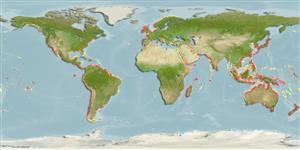Common names from other countries
Environment: milieu / climate zone / depth range / distribution range
Écologie
; profondeur 0 - 20 m (Ref. 348). Tropical
Indo-West Pacific, Northern Atlantic and the Mediterranean. Introduced to Western North America (Ref. 75831).
Length at first maturity / Taille / Poids / Âge
Maturity: Lm ? range ? - ? cm Max length : 4.0 cm TL mâle / non sexé; (Ref. 95344); common length : 2.5 cm TL mâle / non sexé; (Ref. 348)
Description synthétique
Morphologie
Shell small-sized, thin and fragile, somewhat translucent, roughly trigonal ovate in outline, with a moderately long and rather high in shape. Anterior margin of valves rather short and rounded, clearly extending forwards beyond the umbones. Ventral margin long and straightish. Outer surface of valves smoothish, with numerous concentric growth lines and a few small radial grooves in front of the umbones. Periostracum smooth and shiny, transparent, closely applied to shell surface and sometimes abraded from the umbones. Hinge line with very small crenulations in front of the umbones, along and a short way behind the ligamental margin. Anterior adductor scar present. Internal margins very thin and smooth, undulate anteriorly in relation to the outer radial sculpture. Colour: outside of shell glossy, yellowish green to olive-brown, typically patterned with about 15 narrow, tenuous, reddish brown stripes on posterodorsal slope (one of which is larger and darker), and a number of irregular transverse bands of the same colour. Interior slightly pearly, with the outer colour pattern more or less showing through.
Minimum depth from Ref. 95344.
Life cycle and mating behavior
Maturité | Reproduction | Frai | Œufs | Fécondité | Larves
Members of the class Bivalvia are mostly gonochoric, some are protandric hermaphrodites. Life cycle: Embryos develop into free-swimming trocophore larvae, succeeded by the bivalve veliger, resembling a miniature clam.
Poutiers, J.M. 1998. (Ref. 348)
Statut dans la liste rouge de l'IUCN (Ref. 130435: Version 2024-1)
statut CITES (Ref. 108899)
Not Evaluated
Not Evaluated
Utilisations par l'homme
| FishSource |
Outils
Sources Internet
Estimates based on models
Preferred temperature
(Ref.
115969): 14.2 - 29.2, mean 27.7 (based on 2935 cells).
Résilience
Haut, temps minimum de doublement de population inférieur à 15 mois (K=1.15).
Vulnérabilité
Low vulnerability (10 of 100).
